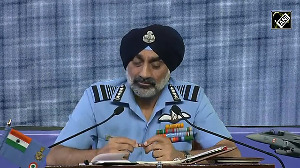Ever since Prime Minister Atal Bihari Vajpayee went to China, and chanted the mantra of combining India's software prowess with China's hardware strengths, everyone's talking of the dragon's giant strides in the hardware sector.
Indeed, with 19 PCs per thousand people and 33 million Internet users, as against India's 5.8 and 7, there's even speculation on how long it will be before China overtakes India in the software sector as well.
Desktop PC market posts 37% growth in 2002-03
Interestingly, however, till just a decade ago, according to Skoch Consultancy Services, India had a pretty good hardware story to tell. When the Pentium chip was pretty new, in the early '90s, 40 per cent of Dell's motherboards were made by Altos, a PCL group firm.
Another local firm, HCL, also used to design and export thousands of motherboards to the US at this time.
One of the first UNIX-based multi-processing machines was designed by HCL and exported to the US - when HCL tied up with Hewlett Packard to produce these, 100 HCL engineers went to HP's labs to explain the designs to their counterparts.
So what happened, why didn't the story develop any further? To an extent it has to do with the industry not being terribly pro-active, but the major reason is, not surprisingly, harmful government policy.
In the 1980s, excise and other duties on local manufacturing were very high, but then so were import duties. Today, import duties are down from their 250-odd per cent levels to around 30, but local duties are around 35 per cent or so, including a 16 per cent excise duty (by contrast, excise duties on manufacturing cell phones is zero per cent).
Naturally, there was no profit to be made by manufacturing in India and then exporting. China's duties are around half of India's, and so with PC prices very low, it's hardly surprising that the market has boomed.
While the export market then died a natural death -- government policy also demanded exceptionally high value addition on exports, based on imported components -- the domestic market was also nipped in the bud.
According to Skoch, for every Rs 100 spent on a computer, Rs 34 accrues to the government, Rs 60 to people like Microsoft, Intel and Samsung, and just Rs 6 is the share of the branded Indian PC manufacturer. This did two things.
One, it ensured PCs were too expensive to do well, secondly it ensured a huge margin for the grey market operator whose sole strength was assembling smuggled parts. The organised hardware industry was never given a real chance.
Today, on an average, you get a new processor every 60 days, so the cost of designing a new PC based on this is prohibitive -- if you can amortise this over a huge production base of say a few million, you're fine, but if the base is small, you're not.
Since the local market was kept small, at around 2 million PCs a year, India's top local manufacturers were forced to import mother boards and other components from Taiwan.
Compared to the '80s, India has few genuine hardware players left. Those that survived, like HCL, did so by channelising their expertise in another direction.
After all, if a firm was designing its own operating system, and writing its own compiler and relational database management systems, it must know something about hardware.
Today, with 2,500 engineers in seven laboratories across the country, HCL designs networking/hardware solutions in a business worth around $150 million -- total industry numbers are around $700 million. In other words, global hardware firms are buying these designs, and producing billions of dollars worth of hardware -- PCs, servers, hard disks - based on them.
After a major lull from the mid-'90s, thanks to some major restructuring/re-focussing, India's hardware sector is once again showing signs of life.
Moser Baer in Noida is one of the world's largest producers of CDs, American Power Corporation exports large volumes of its UPS' out of India, most of the power supply systems for PCs that are produced by Tandon are manufactured in India.
The Simputer, similarly, is a fully Indian-designed product with great potential, since its Linux-based operating system allows great flexibility in applications.
Companies like HCL, as part of the same hardware-revival story, are also coming up with changes in architecture (that's geek jargon for whether you do your processing in your PC itself or in a server connected to several PCs) that are dramatically lowering costs.
A 'thin client' PC solution being bought by Life Insurance Corporation of India, for instance, is going to cost it just Rs 15,000 per terminal, as against Rs 40,000 or so if the conventional PC solution was used -- it was at IIT Mumbai's Affordable Solutions Lab, in fact, that LIC tested this new solution, and according to D B Phatak who heads the lab, banks like SBI and PNB are also looking at such solutions now.
HCL has also, though for a Malaysian firm, designed a new PC, based completely on Linux, and offering a full complement of software (like Word, Excel, etc) based on open-source systems in place of the usual Microsoft solutions -- immediately, the cost of a PC has gone down a third.
You've seen what the industry's been doing and what it's capable of, now just imagine what will happen if the government decides to pitch in by slashing the various tariffs on the sector.
With imaginative financing schemes -- such as the one, which allowed Reliance Infocomm to sell an astounding 500,000 CDMA-mobile phones in just five days of its Monsoon Hangama offer -- the PC market just has to explode.
Monsoon Hangama: Biggest gamble of allTRAI to probe Reliance, BSNL tariffs
When that happens, and volumes pick up, large-scale hardware manufacturing in India will become viable. His political compulsions notwithstanding, Vajpayee's mantra will just have to be Indian software with Indian hardware.





